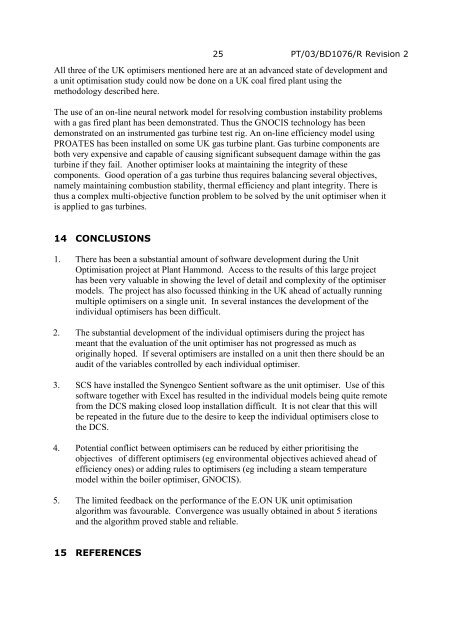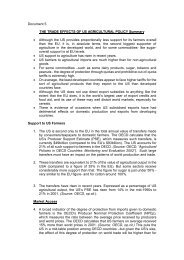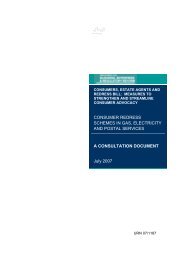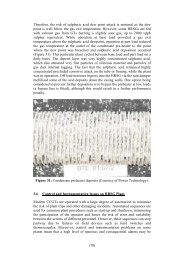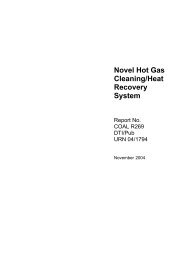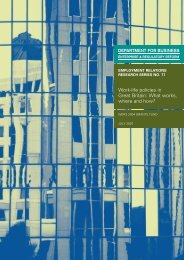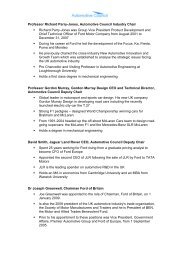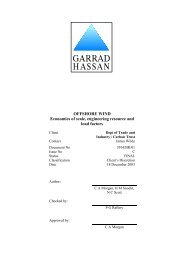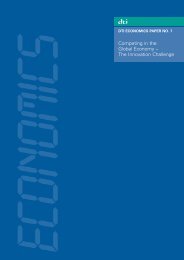Coal Fired Power Plant Operations - DTI Home Page
Coal Fired Power Plant Operations - DTI Home Page
Coal Fired Power Plant Operations - DTI Home Page
You also want an ePaper? Increase the reach of your titles
YUMPU automatically turns print PDFs into web optimized ePapers that Google loves.
25 PT/03/BD1076/R Revision 2<br />
All three of the UK optimisers mentioned here are at an advanced state of development and<br />
a unit optimisation study could now be done on a UK coal fired plant using the<br />
methodology described here.<br />
The use of an on-line neural network model for resolving combustion instability problems<br />
with a gas fired plant has been demonstrated. Thus the GNOCIS technology has been<br />
demonstrated on an instrumented gas turbine test rig. An on-line efficiency model using<br />
PROATES has been installed on some UK gas turbine plant. Gas turbine components are<br />
both very expensive and capable of causing significant subsequent damage within the gas<br />
turbine if they fail. Another optimiser looks at maintaining the integrity of these<br />
components. Good operation of a gas turbine thus requires balancing several objectives,<br />
namely maintaining combustion stability, thermal efficiency and plant integrity. There is<br />
thus a complex multi-objective function problem to be solved by the unit optimiser when it<br />
is applied to gas turbines.<br />
14 CONCLUSIONS<br />
1. There has been a substantial amount of software development during the Unit<br />
Optimisation project at <strong>Plant</strong> Hammond. Access to the results of this large project<br />
has been very valuable in showing the level of detail and complexity of the optimiser<br />
models. The project has also focussed thinking in the UK ahead of actually running<br />
multiple optimisers on a single unit. In several instances the development of the<br />
individual optimisers has been difficult.<br />
2. The substantial development of the individual optimisers during the project has<br />
meant that the evaluation of the unit optimiser has not progressed as much as<br />
originally hoped. If several optimisers are installed on a unit then there should be an<br />
audit of the variables controlled by each individual optimiser.<br />
3. SCS have installed the Synengco Sentient software as the unit optimiser. Use of this<br />
software together with Excel has resulted in the individual models being quite remote<br />
from the DCS making closed loop installation difficult. It is not clear that this will<br />
be repeated in the future due to the desire to keep the individual optimisers close to<br />
the DCS.<br />
4. Potential conflict between optimisers can be reduced by either prioritising the<br />
objectives of different optimisers (eg environmental objectives achieved ahead of<br />
efficiency ones) or adding rules to optimisers (eg including a steam temperature<br />
model within the boiler optimiser, GNOCIS).<br />
5. The limited feedback on the performance of the E.ON UK unit optimisation<br />
algorithm was favourable. Convergence was usually obtained in about 5 iterations<br />
and the algorithm proved stable and reliable.<br />
15 REFERENCES


